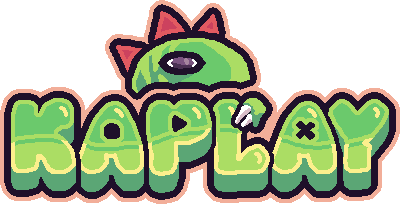Particles
The particles() component component is a very efficient way of display tons of visual
feedback, due to its optimized nature internally on KAPLAY.
Creating a Particle Emitter
There are two parts to particles in KAPLAY, the particle emitter and the particles themselves. Both the particles and the particle emitter have options for us to modify, and come with important features to affect how our particles will appear.
let particleEmitter = add([
pos(center()),
particles(
{
max: 20,
speed: [50, 50],
lifeTime: [1, 2],
},
{
direction: 0,
spread: 45,
},
),
]);Above is what the general setup of a particle emitter should look like.. The
first set of options is the ParticlesOpt, and the second set is the
EmitterOpt. The ParticlesOpt is composed of options related to what the
particle will be doing after it is emitted, while the EmitterOpt is composed
of options related to where, when, and what direction each particle will be
emitted.
Particle Textures in a Particle Emitter
Using a particle emitter requires us to use the texture and frames data of a
sprite. There are multiple options for how to access this, but the easiest is
using the built-in getSprite().data function to generate our particles. Below
is an example on how to use textures for a particle emitter. Don’t forget to
wait for your sprites to load!
// load the sprite, and wait for the sprite to fully load before making the particle emitter
// NOTE: this is the easiest way to ensure your a sprite has been loaded, but not the best
loadSprite("bean", "./sprites/bean.png").then((data) => {
let loadedSpriteData = getSprite("bean").data;
// Fun fact: the data parameter passed from the promise is the same as getSprite().data
let particleEmitter = add([
pos(center()),
particles(
{
max: 20,
lifeTime: [1, 3],
texture: loadedSpriteData.tex, // texture of the sprite
quads: loadedSpriteData.frames, // to tell whe emitter what frames of the sprite to use
},
{
direction: 0,
spread: 45,
},
),
]);
});Using a Complete Particle Emitter
To spawn particles from the emitter, we can just use particleEmitter.emit(n),
where n is the amount of particles we want to spawn.
// Emit at runtime
particleEmitter.emit(5);
// Emit once a frame, good for prolonged effects
onUpdate(() => {
particleEmitter.emit(1);
});
// Emit on event call, good for bursts of projectiles. (like an explosion)
on("randomEvent", () => {
particleEmitter.emit(25);
});Below is a complete example of how we should use the particles() component,
along with explanations on each option in the options for particles()
// load the sprite, and wait for the sprite to fully load before making the particle emitter
// NOTE: this is the easiest way to ensure your sprites have been loaded, but not the best
loadSprite("bean", "./sprites/bean.png").then((data) => {
// Fun fact: the data parameter passed from the promise is the same as getSprite().data
let loadedSpriteData = getSprite("bean").data;
let particleEmitter = add([
pos(center()),
particles(
{
max: 20, // the max amount of particles generated from this emitter at one time
lifeTime: [2, 5], // how long the particles last before being destroyed
speed: [50, 100], // how fast the particles are moving
acceleration: [vec2(0), vec2(0, -10)], // changes the speed of the particle over its lifetime
damping: [0, 0.5], // slows down the particle over its lifetime
angle: [0, 360], // the rotation of each particle
angularVelocity: [0, 100], // how fast each particle should be rotating
scales: [1.0, 0.5, 0.0], // how large the particle is over its lifetime
colors: [RED, GREEN, BLUE], // the color of the particle over its lifetime
opacities: [1.0, 0.0], // the opacity of the particle over its lifetime
texture: loadedSpriteData.tex, // texture of the sprite
quads: loadedSpriteData.frames, // to tell whe emitter what frames of the sprite to use
},
{
shape: new Rect(vec2(0), 32, 32), // the area where particles should be emitted from (can be empty)
lifetime: 5, // how long the emitter should last
rate: 5, // the rate at which particles are emitted
direction: 0, // the direction where particles should be traveling
spread: 45, // variance in the direction where particles should be traveling
},
),
]);
// .onEnd is called when the emitter's lifetime (in this example 5 seconds), has expired.
particleEmitter.onEnd(() => {
destroy(particleEmitter);
});
// Emit Particles at runtime
particleEmitter.emit(5);
// Wait 1 second, then emit more
wait(1, () => {
particleEmitter.emit(15);
});
});
